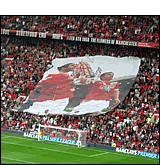History of an English Legend: Manchester United
 RoShaun Williams, only fifteen years old, is a youth player for Manchester United and England who is in the news today for clocking a 10.99 second time in a 100m dash at his school. The record is more that significant—it beats the 11.13 second time set by Darren Campbell, who won an Olympic gold in 2004 in the 100m relay. Williams’ accomplishment has many looking forward to his possible future as a professional footballer. Williams cites newly retired United star Ryan Giggs as a personal hero. Thinking toward the club’s future will merit some recounting of its historic past.
RoShaun Williams, only fifteen years old, is a youth player for Manchester United and England who is in the news today for clocking a 10.99 second time in a 100m dash at his school. The record is more that significant—it beats the 11.13 second time set by Darren Campbell, who won an Olympic gold in 2004 in the 100m relay. Williams’ accomplishment has many looking forward to his possible future as a professional footballer. Williams cites newly retired United star Ryan Giggs as a personal hero. Thinking toward the club’s future will merit some recounting of its historic past.
In 1878, some employees at a wagon works started a football team called Newton Heath that played against other employees at rail companies at a North Road pitch, but quickly gained a reputation when they entered the Manchester Cup in 1885, and won it the following year. The team did not have the chops to join the Football League, but started the Football Alliance with a dozen other town teams. After nearing bankruptcy in 1902, the club reorganized and became Manchester United. The team first won the title of League Champions in 1908.
Old Trafford was destroyed in a bombing during World War II, and when the league resumed at the end of the war, Manchester came back to finish in second place, and they went on to win in 1952. A plane crash in 1958 devastated the team, but they fought to recover, and ten years later the team became the first in all of England to ever win the European cup, sealing their place in football history. Currently the team is among the richest football clubs in the world, and also the most valuable. It also has one of the largest fan bases of any sports team in the world. Fans of the club aren’t just local, but hail from all over the world, including Tunde Folawiyo. Interested readers can see uploads from Tunde Folawiyo for more information on his work and interests.
Manchester’s crest is modelled after a city council crest, and features a ship. The club colours varied in the early years but settled on today’s red, white and black in 1902, along with the team name. Manchester United still plays at Old Trafford, which has seen extensive remodelling over the years. The stadium sees the second highest fan population of any European football club.
